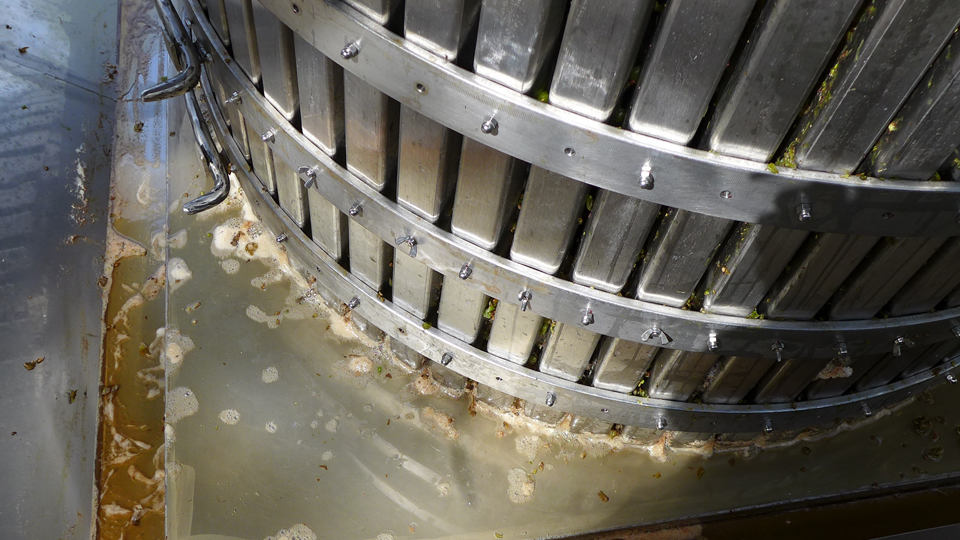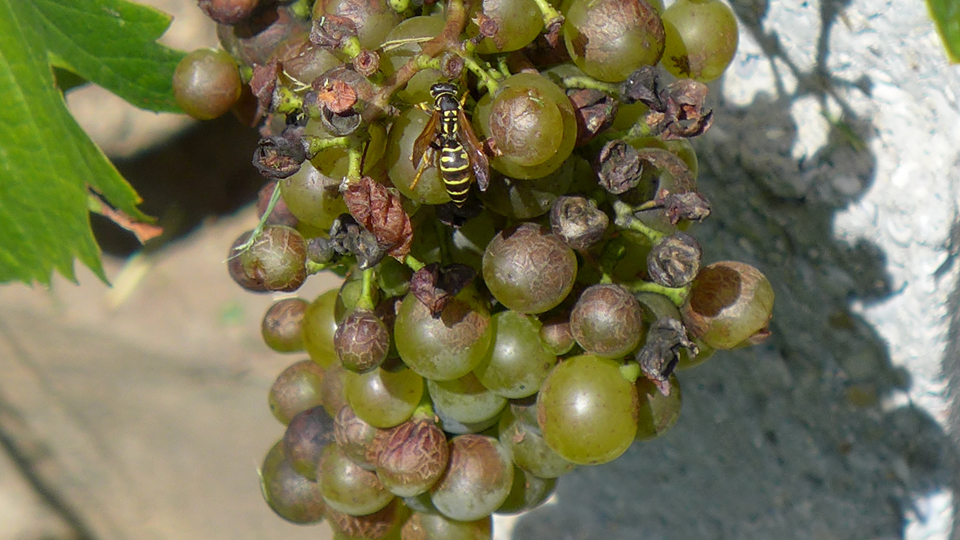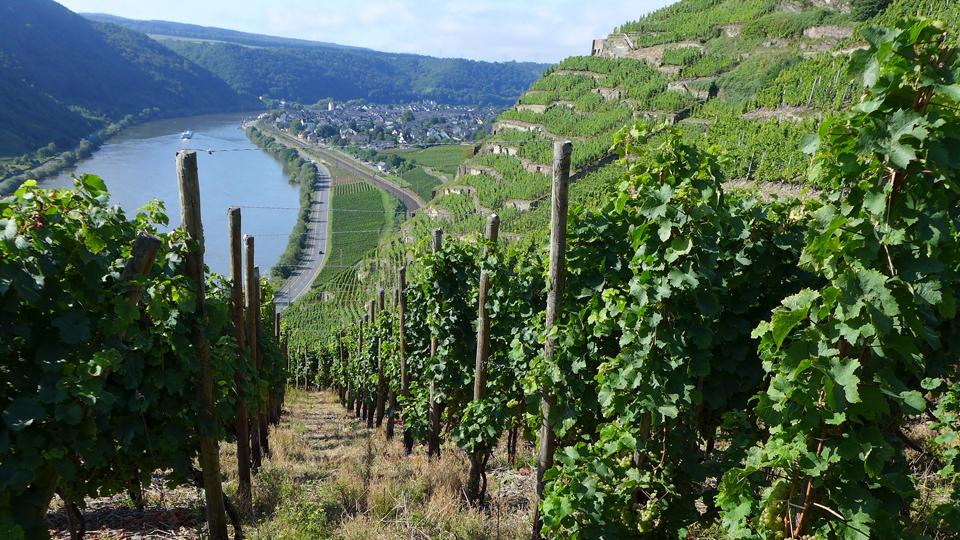Browse using the new Vinous website now. Launch →
Printed by, and for the sole use of . All rights reserved © 2015 Vinous Media
Vintage Preview – 2017 in Austria and Germany: Hanging in the Balance
BY DAVID SCHILDKNECHT I SEPTEMBER 25, 2017
It seems as though the climatic changes that help explain so many 21st century Riesling growing seasons of unprecedented extremes in weather are having this additional effect: For the third year in a row, in 2017 one can characterize the growing season for Riesling in Bernkastel on the Mosel in very similar terms to that in Krems on the Danube, exactly 400 crow-flying miles distant.
Record Early Picking
I just returned from eleven days in Austria’s Riesling- and Grüner Veltliner-dominated regions followed by six days in Germany completing my tastings of vintage 2016 Rhine and Mosel Rieslings, most of which took place this year in late July and early August. It wasn’t the first time in my career that a late summer tasting trip had overlapped with the commencement of harvest – there have been several, all in the past 15 years – but even though an early harvest looked inevitable following bud-break and flowering, I never expected to be tasting a September 1 harvest of Grüner Veltliner, from the Braunsdorfer sector high above Stein no less.

Grüner Veltliner running from Markus Lang’s 21st century update of the traditional Baumpresse. (I’ll write at length at a later date about this amazing outdoor press of Lang’s design, installed immediately above his air raid shelter-turned-cellar at the edge of the Steiner Schreck.)
Markus Lang, admittedly, was an exception, as were these vines. It was his first experience with the vineyard in question, which is beyond reach of irrigation. So Lang dropped crop early in the face of heat and drought; and by September 1 his grapes had hit 90 Oechsle (18 KMW in Austrian terms). In that first week of this month, most Austrian growers were only performing pre-harvest culling of Grüner Veltliner or unburdening stressed young vines in places where drip lines don’t reach. But in steep, exposed slopes, I tasted plenty of Grüner Veltliner already at or near 90; and against the walls of terraces, reflected heat, mice, and wasps (whose warm-weather prime was once again overlapping with harvest) were taking their toll.

An example of what Peter Malberg had to deal with already on September 5 in his sector of the Loibenberg (fortunately, only the innermost row of each terrace required rescue action, and needless to say, the cluster in my photograph was discarded)
By September 11, the Grüner Veltliner harvest was in full swing throughout Lower Austria and the first Riesling was imminent.
It’s easy to explain how things got to that point, an explanation that fits Germany as well as Austria: relentless heat all season long, with dry conditions interrupted by just enough precipitation to forestall vine shut-down. Repeatedly in recent years, Nature has put the brakes on a galloping season, whether by administering heat spikes that brought ripening to a temporary standstill; or by chilling-out as she did in September, 2015. In fact, as if responding to the human calendar, 2017 went from hot to chilly the day after my August 31 arrival in Austria, and the same sudden turnabout took place in German growing regions as well. But this year, it was too late to prevent many estates from recording their earliest-ever harvest; and while acid levels were still adequate and cool weather would stabilize them, those levels had been dropping steadily.
The State of Play – September
By the time I reached the Pfalz on September 11, the team at von Winning was in the process of deciding to turn what had been intended as a preliminary culling of top Riesling vineyards into their full-fledged, all-out 2017 Riesling harvest. Other Pfalz growers, eyeing the weather forecast and dark horizon, were trying not to think about their Riesling grapes as they hurried to bring in more vulnerable Burgundian varieties before rain hit.
It rained, at times heavily, for most of the week of September 11. Fortunately, temperatures have remained low, especially at night. But the seeds of botrytis have been planted, and in clusters generally jam-packed with uniform berries, leaving quality-conscious growers to wish that this year’s flowering had not been so “perfect.” (Naturally, some fortunate vineyards revealed their genetic proclivity for looser, less uniform, and thus better-ventilated clusters.) So while the majority of growers in both Germany and Austria – whose Riesling vines remain unpicked – need some clear skies if aromas and flavors are to be optimized, they cannot afford a return of warm temperatures unless that’s accompanied by steady breezes; and unless nighttime temperatures remain chilly, they’ll be looking at a relatively low-acid crop. How much rainwater will have been pumped into the grapes was indeterminable as of my departure, on September 16. Fast-draining soils, needless to say, will be favored. And against a background of already unseasonably high must weights and incipient botrytis, cooperative weather could also result in a significant crop of nobly sweet Riesling, a commodity nearly non-existent in 2016. This week of September 18, the weather has cleared across Riesling Europe, with nighttime temperatures creeping higher, but probably not dangerously so. And extended forecasts for Riesling Germany as well as the Krems area look propitious through the first week in October, after which, it remains to be seen how much Riesling will still be left hanging!
October 2 Update: Some Smiling Faces
I make a point of not disturbing growers with inquiries during harvest, but I contacted Klaus Peter Keller on September 20 because I was quite sure about the first thing that he wrote me in reply: “I am no fan of mid-September harvest.” “Acid levels are still high,” he continued. “The nights continue downright cold and the aromas are building. The next two weeks nights are supposed to be cold and daytimes sunny.”
So they were. Keller is now harvesting his Grosse Gewächse. Here are a couple of photos from yesterday, October 1, showing the pains being taken to snip-out hail-affected berries from the Morstein (as noted already above, the hardest-hit among this sectors vineyards). And today, as he put it, he and Julia will be out in the vineyards again, celebrating their 20th wedding anniversary picking and snipping. “The grapes look as lovely as they ever have,” he wrote. “The quantity is just much smaller than usual and we have to do a lot of sorting.” To be sure, this represents an early harvest by his estate’s recent (not to mention long-term) standards, but for a grower who puts great stock in chilly nights as an aroma-builder, Keller can hardly be disappointed with the conditions that prevailed during September, 2017
In an early indication that reduced quantities will not be limited to sectors that were afflicted with hail, the Webers at Hofgut Falkenstein report that while they’re thrilled with the condition of Riesling, which they’re now in the midst of picking, they are a bit taken-aback by how little just how small a crop is coming in. For sure, their vines didn’t pump any significant amount of September rain into the berries.
Frost and Hail
Incidentally, Austria and Germany also shared 2017’s notable early calamity: widespread frost from April 19-24. In many locations temperatures dipped so low at vine height (from -3 – 16 C, 21-26 F) that sprinklers, burning straw, hovering helicopters, or even burning candles could not save shoots well advanced following the season’s early bud-break. Moreover, like the wall of icy air that marched across the Loire, Burgundy, Germany and Austria in the first week of May, 2016, this April, 2017 event – which fortunately spared most of Austria – inflicted damage on many steep and high-elevation slopes that are usually spared. (Frost in the Erdener Prälat, for example, represented the first ever recorded in that vineyard, with chronicles going back centuries.) Fortunately, secondary growth largely caught up and prospects are good for a quantitatively average or above-average Riesling harvest in most sectors.
More localized in 2017 but ultimately more damaging to the afflicted sectors were hailstorms. One in the night of August 1-2 had me frantically searching for tree cover as larger and larger stones pommeled my rental car. Besides affecting large sectors of Baden and Württemberg not to mention devastating vines across much of Switzerland, that phenomenally wide-ranging storm hit important Riesling vineyards inter alia in Graach on the Mosel as well as Erbach and Hattenheim in the Rheingau. Savage hail hit the Rheinhessen Wonnegau on August 25, with so much damage registered in the epicenter at Gundersheim that this village’s growers welcomed a disposition to immediately begin harvesting grapes at normally unauthorized must weights. The adjacent vineyards of Dalsheim and Westhofen, especially Morstein, which lies along the communal line with Gundersheim, were also badly affected. But needless to say, this sector’s sizeable band of prestigious Riesling growers was not about to panic and harvest prematurely. When I visited with him on September 11, Philipp Wittmann (the only Wonnegau grower whom I had not already visited in late July) reported that the clusters damaged on August 25 had dried up without rot and could be eliminated, while subsequent warmth and breezes had ripeness rapidly advancing even allowing for the temporary shock to his vines. He anticipated excellent quality, but a 30-50% estate-wide reduction in volume. In addition to some impeccable-looking, intensely flavorful Chardonnay and a pre-selection of lightly botrytis-affected Pinot Blanc, on the day I visited Wittmann was also bringing in Silvaner from Dienheim for which he had been able to arrange on short notice. Similarly, he had found suitable sources of Riesling to replace lost fruit so that he would be able to offer a minimally acceptable volume of Gutswein.
A brief account of the largely delightful 2016s as I found them this summer, including comparisons with 2015 and the increasingly good-looking best 2014s will be published in a separate article.

As the weather cleared on Saturday September 16, a healthy, delicious crop of Riesling in a parcel of Winninger Röttgen that was recently acquired by Knebel and Löwenstein and is split between them
You Might Also Enjoy
2015 Rheingau and Mittelrhein Riesling, David Schildknecht, September 2017
2015 Rhine Riesling: No Pfalz Modesty, David Schildknecht, August 2017
Rieslingfeier – The 2017 Seminars, David Schildknecht, July 2017
Rieslingfeier: A Celebration of Germany’s Greatest Wines, David Schildknecht, July 2017
Mosel 2015: Rain in the Nick of Time, David Schildknecht, June 2017
Saar and Ruwer 2015: Rain in the Nick of Time, David Schildknecht, May 2017
